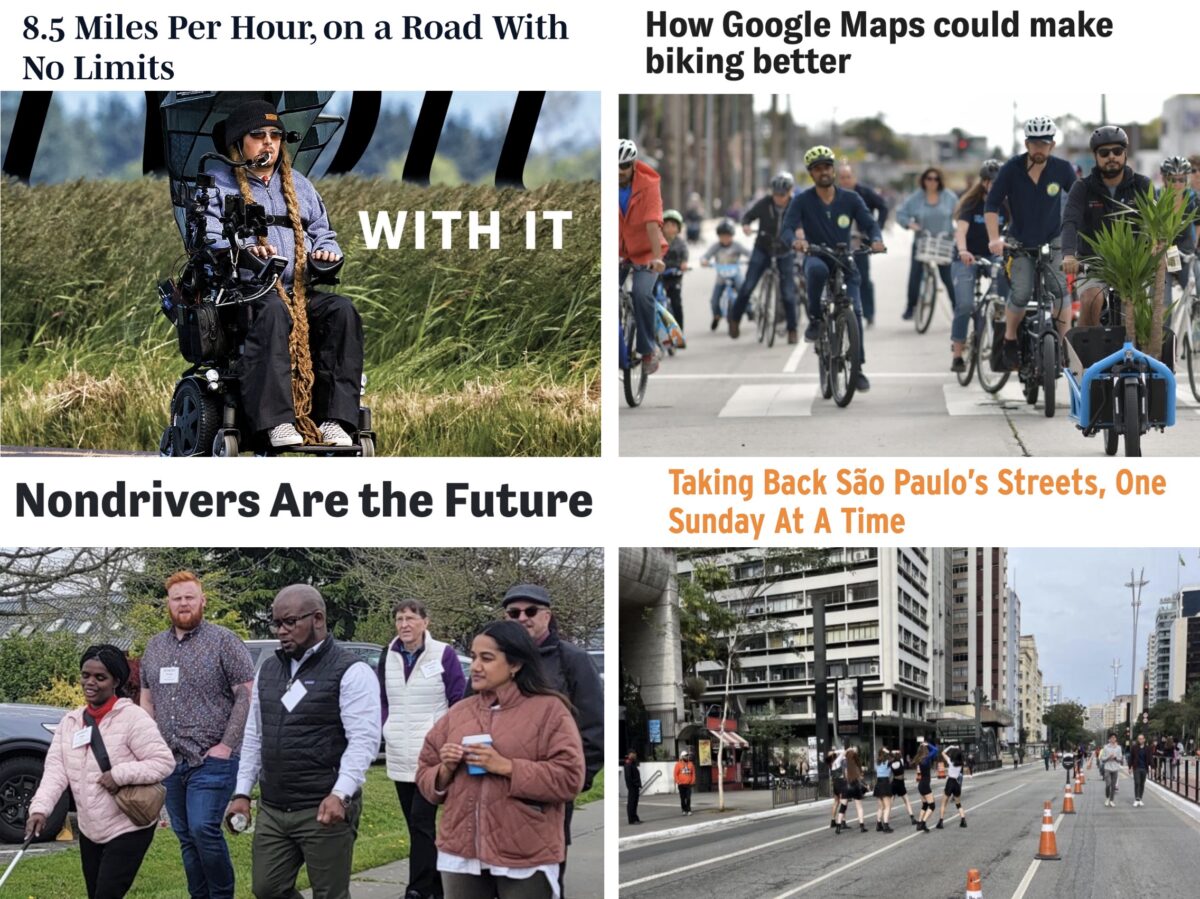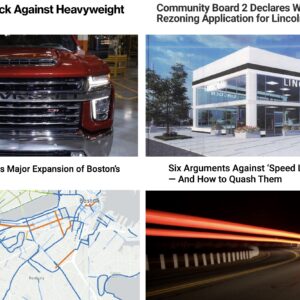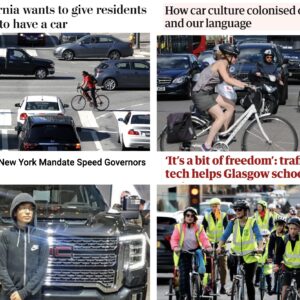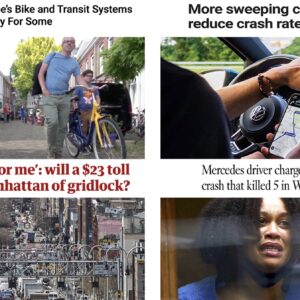Welcome to the week.
Here are the most notable stories our writers and readers came across in the past seven days…
Ian’s amazing ride: Former bike rider Ian Mackay broke the Guinness World Record for most miles in a motorized wheelchair on Sauvie Island this past summer and this article captures all of its beauty. (Sports Illustrated)
People love carfree streets: The mayor of São Paulo, Brazil faced opposition from business groups for banning cars on a major street every Sunday; but now it’s overwhelmingly popular and people want even more. (Next City)
Better Google Maps: Google has the data and the programmers needed to make much safer and lower-stress biking directions. (Protocol)
We’re the worst!: Check this data visualization that illustrates how the mighty and rich US of A has become one of the most dangerous places to drive, bike or walk in the world. (League of American Bicyclists)
Not everyone can (or wants to!) drive: Anna Zivarts lays out the case for why “nondrivers are the future” and says the fact that 1/3 of Americans don’t have a driver’s license should increase urgency for low-car policies and projects. (The Stranger)
Portland cargo bike PR: The Disaster Relief Trials event has received some well-deserved attention via a profile feature in a national magazine complete with a professional photo layout. (Wired)
Unequal pay: There’s a massive pay gap in professional women’s cycling and nearly a quarter of WorldTour riders don’t get paid to race at all. (Cycling Weekly)
Boondoggles: Keep up-to-date with America’s wasteful spending on highway expansion projects with this seventh annual report. (US PIRG)
RIP bike share: Bike share in Salem has died because it was starved for funding and its operators (a nonprofit) couldn’t keep up with maintenance. (OPB)
Power of walking: We can never have too many inspirational essays about the remarkable power of simply going for a walk. (NY Times Opinion)
Find your ride: This cool new website can help you discover which vehicle is right for you — as long as it’s not a car.
Thanks to everyone who sent in links this week!






Thanks for reading.
BikePortland has served this community with independent community journalism since 2005. We rely on subscriptions from readers like you to survive. Your financial support is vital in keeping this valuable resource alive and well.
Please subscribe today to strengthen and expand our work.
Re: “We’re the Worst!”(Traffic Fatalities), that chart is fairly shocking. I wonder what Russia did to reduce fatalities so much in a decade? Also interesting to see the “safest” top 10 or so countries just trading places in the lead as their #s drop. Meanwhile, we just slowly drop to the bottom/deadliest spot.
I blame it on an increase in bigger, and ever more powerful and faster vehicles, plus an increase in distracted driving. People walking and biking have stayed the same size, but the things speeding past us have grown ever more dangerous. I’m really hoping we can get the NHTSA to start demanding pedestrian safety as part of vehicle design standards. Until then we’re stuck with distracted drivers speeding to their office jobs in huge death trucks.
Until 2020, our number mostly stayed constant, while the other countries improved. There was, unsurprisingly, a big jump in 2020, which I attribute less to trucks and phones and more to people mistaking Mad Max for driver training.
The easiest way to reduce reported traffic fatality rates is to not report them at all, to control the media, both on a national level and locally, and imprison anyone who does make such reports public – hence the falling rates in Russia, Kazakhstan, Azerbaijan, and several other countries with tightly-controlled media.
Google Maps for bikes is what it is. I treat their suggested routes as just that: a suggestion. I almost always deviate from their directions when riding.
I use their turn-by-turn for bike directions with my earbuds in. I don’t even bother looking at the route live on my screen (phone in pocket) because I know I’m probably going to deviate from it. It will tell me where to go as I approach the next navigation action, but when I disagree I just take the turn (or not) that I want to trust. Then, before I reach the next intersection, it’s already figured out the rest of the reroute. This method is especially useful tor getting TO and OFF the east side esplanade, particularly for Morrison Bridge access, which Google seems highly confused by.
Take a look at Oregon’s featured highway boondoggle at https://pirg.org/resources/i-205-widening-oregon/
ODOT decided to widen I-205, then they decided to apply tolls, but they refuse to consider whether traffic volumes will fall due to the tolls, rendering the project uneconomic, and they refuse to look at using toll revenue to operate express bus service as an alternative to widening.
What I find so interesting about the Boondoggle report is all the really expensive pointless highway projects that USPIRG decided not to cover, particularly in New England and New York, not to mention the new bridge over the Columbia.
Sorry to hear about bikeshare in Salem closing down…its not surprising, as running a bikeshare transit service from just ‘locals’ customer farebox reveneue and business donations is tough even in the best of years and gets more difficult as time goes on (equipment replacement costs / ‘wear and tear’ + dead-end legacy hardware/ software, and donor fatigue). The adoption of the Zagster equipment ‘likely’ did have greater ‘exposure’ to theft problem than more robust top tier bikeshare equipment would have (from what I saw when I looked into partnering with them in ~2016)…but that lower cost & lower bar to market entry made bikeshare more accessible for smaller communities and campuses that might now have attracted the big players…but that is only as long as the community respects the service, etc.
PS. Good luck to Salem Bike Share v3 if the Oregon funds do come through.
Being in a rural area, I’d love for a map platform that distinguishes between paved and gravel roads, and that allows people to make comments on current conditions, whether they be potholes, construction, and/or malicious dogs.